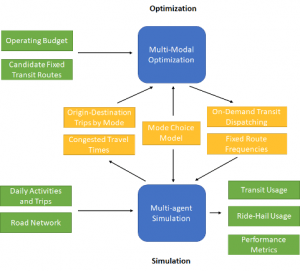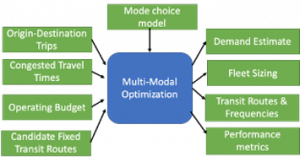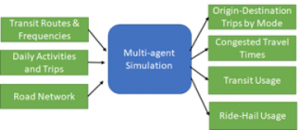
Transit agencies have vast experience meeting these objectives subject to budget and other constraints. However, the surrounding conditions are shifting rapidly with emerging travel modes, shifting travel behavior, and a global pandemic disrupting the status quo. T-SCORE will develop a set of analytical tools consisting of a mathematical optimization procedure coupled with a multi-agent simulation, linked by a feedback and evaluation loop. The approach draws heavily from inputs generated by existing regional travel demand forecasting models, enabling the research to be “shovel ready.”
The MMOS track aims to quantitatively evaluate the visions identified during the Strategy Generation activities to answer operational questions such as:
- How to allocate transit vehicles to minimize travel times for essential workers and those with limited mobility?
- Given a fixed operating budget, how do we max throughput on high-volume corridors?
- Is there a pricing / incentive strategy that minimizes trips with high external costs?
- Given capacity limitations introduced by social distancing directives, how could we balance the competing objectives of high ridership and low crowding?
The following graphic summarizes the overall work structure for the MMOS track, with more detailed descriptions of each project included below.

The code for the following projects is available here: https://github.com/tscore-utc
Project M1: Multi-Modal Optimization
This project will develop a model to generate an optimal set of transit routes and frequencies given the input demand and constraints. The starting point for the optimization model are those developed for a NSF-funded project – Socially Aware Mobility (SAM) project – that seeks to design coordinated microtransit systems in large congested cities. These systems combine on-demand transit that serve low-density regions with high-occupancy vehicles (buses or trains) traveling along high-density corridors. The optimization will will include discrete choice models that capture, for each class of riders, the choice between the proposed transit system, personal vehicles, and ride-hailing services.

Project M2: Multi-Agent Simulation
The objective of this project is to develop a simulation model capable of representing tradeoffs between fixed route transit, coordinated on-demand transit, independent ride-hail operators, and other travel modes. Regional travel models as currently constructed do not attempt to handle the intricate relationship between supply for and demand of on-demand transit and independent ride-hail services. The simulation will be implemented in the open-source MATSim simulator to evaluate the strategies envisioned by the Center with the necessary choice of coordinated and competing modes.

Project M3: MMOS Integration
The major effort and innovation in this project is in managing the feedback and evaluation convergence within and between the models, and extracting standard performance metrics. Together the integrated MMOS provides a recommended transit service provision and an estimate of the resulting ridership and impacts, summarized to generate performance metrics.
The full report for the following project is available here: https://rosap.ntl.bts.gov/view/dot/67058
Project M4: Implementation and Quantitative Evaluation
We will implement the integrated MMOS in Salt Lake City to evaluate the strategic directions envisioned by the Center. Additionally, we will work directly with staff from San Francisco County Transportation Authority (SFCTA) and the Metropolitan Transportation Commission (MTC) to transfer the MMOS to their context. By implementing the MMOS for both a medium and a large city we will be able to evaluate the effects of the strategic directions in different contexts and set ourselves up for tech transfer to other regions.

